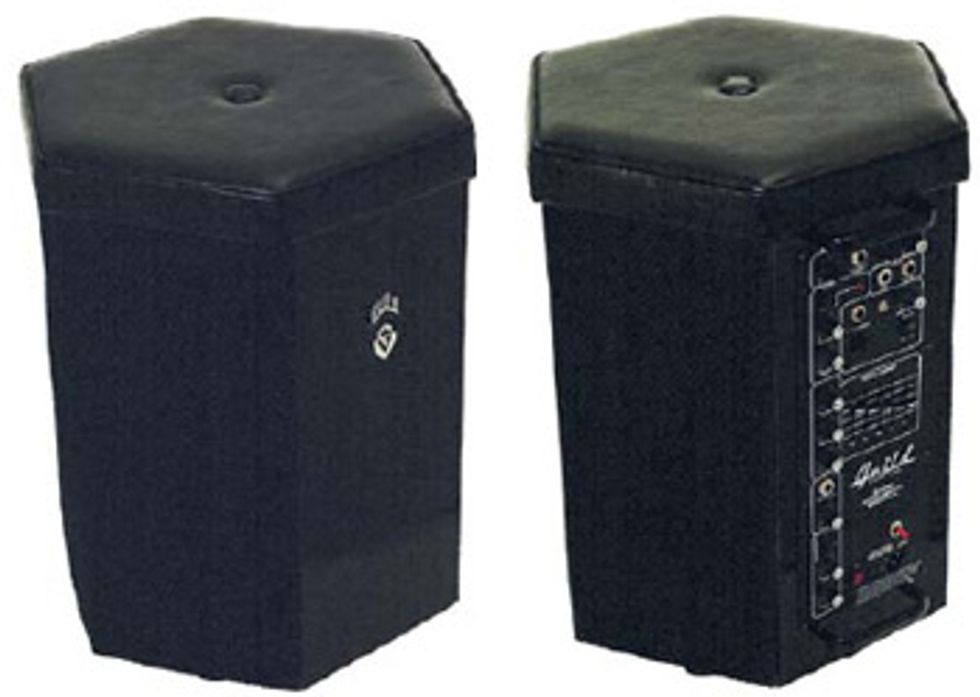
Left: The Guild G-1000—a 2-channel “acoustic” amp with a built-in seat cushion. Right: The G-1000 boasts a 90-watt tri-amped power section with stereo tweeters and an integrated subwoofer.
Hey Zach,
Here’s a weird one for you, but I know you like them that way! I bought this Guild amplifier at a guitar show in the late 1990s. Not only does it look cool, but the padded seat allows me to keep it in my living room and use it as an extra chair—talk about versatile. I believe it’s from the late 1980s or early 1990s, and I think it might be one of the first acoustic amps ever. What do you think? —Ethan in Dayton, Ohio
Hey Ethan,
Cool amp, man. You rarely see these amps around, and to find one in working order (solid-state technology was far from perfect in the early 1990s) and in this condition is especially unusual.
Guild produced a variety of tube amplifiers during the 1960s and 1970s that have much vintage-collector appeal. After Guild’s founder and president Alfred Dronge was tragically killed in a self-piloted airplane crash in 1972, Guild found itself bought and sold several times over the next two decades. Through the 1970s and most of the 1980s, Guild offered a line of solid-state electric guitar amps that seemed to exist simply for the sake of having amps in their catalog. And by the late 1980s, Guild’s focus was mainly on acoustic production.
In the early 1990s, Guild introduced a line of amplifiers designed specifically for use with acoustic-electric guitars. The first was the G-1000, and it featured a unique hexagonal cabinet with a cushion-seat top. According to a 1993 brochure, these new amplifiers “accurately reproduce that unique natural acoustic sound—without alteration.”
The G-1000 has four 6" speakers and a 10" subwoofer, all driven by a tri-amp power section with a total RMS output of 90 watts. The four 6" speakers are split into two groups and configured in stereo, with a pair of speakers on each side of the cabinet. Each side is driven by a 30-watt amp and the remaining 30-watt amp is dedicated to the 10" subwoofer. Other features include a preamp that users can switch to match either active or passive pickups, reverb, a 5-band graphic EQ, an isolated effects loop, instrument and balanced XLR mic inputs with separate level controls for each, and an unbalanced 1/4" output jack. A fiber travel case with footswitch and removable casters was also included. Lastly, the G-1000 was available in ebony or mahogany with a mother-of-pearl Guild logo, and, of course, the padded seat cushion!
As acoustic guitars with piezo saddle pickups became increasingly popular in the 1980s, many guitarists complained that their instruments sounded unnatural when heard through a standard guitar amplifier. Specifically, most acoustic guitarists sought clarity—not distortion—in their amplified sound. To meet this demand, manufacturers began building “acoustic” amplifiers with multiple speakers, clean power sections, and even stereo output. These devices typically offered anti-feedback capabilities and multiple inputs for both guitars and microphones—features you often don’t find in regular guitar amps.
Believe it or not, Marshall is probably the first manufacturer to offer an acoustic style of amp. Their Club and Country series were tube amps designed for country musicians and were produced during the late 1970s. They even had a brown covering and a straw grille! While not specifically considered an acoustic amp, they were wired to sound clean and clear. The first official acoustic amplifiers appeared in the late 1980s and early 1990s. Peavey introduced the Reno 400, Trace Elliot launched the TA Series line of acoustic amps, and Guild presented the G-1000. All three thrived early on, and Peavey and Trace Elliot continue to offer acoustic amplifiers. Guild introduced a full line of acoustic amplifiers called the Timberline series, which were produced until circa 1994. When Fender purchased Guild in 1995, they ceased amplifier production.
Just about every other major manufacturer jumped on the acoustic amplifier bandwagon in the mid to late 1990s. Fender introduced their Acoustasonic series in 1998. A newer company, Ashdown Engineering, launched their Acoustic Radiator series in 1999. Genz Benz produces their popular Shenandoah series and Rivera offers their tube-driven Sedona line. Today, guitar amplifier companies exist that focus solely on acoustic amplification including Ultrasound, Acoustic Image, and AER. You’ll also find that most of the large manufacturers offer at least one acoustic amplifier in their lineup.
While I can’t say that your Guild G-1000 was the first acoustic guitar amplifier out there, it was certainly on the forefront of acoustic amplification in the early 1990s. This amp is too cool not to be a treasure!
 Zachary R. Fjestad
is author of Blue Book of
Acoustic Guitars, Blue Book
of Electric Guitars, and Blue
Book of Guitar Amplifiers.
For more information, visit
bluebookinc.com or email
Zach at guitars@bluebookinc.com.
Zachary R. Fjestad
is author of Blue Book of
Acoustic Guitars, Blue Book
of Electric Guitars, and Blue
Book of Guitar Amplifiers.
For more information, visit
bluebookinc.com or email
Zach at guitars@bluebookinc.com.









![Rig Rundown: Russian Circles’ Mike Sullivan [2025]](https://www.premierguitar.com/media-library/youtube.jpg?id=62303631&width=1245&height=700&quality=70&coordinates=0%2C0%2C0%2C0)









